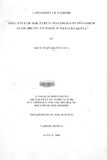| dc.description.abstract | Potassium (K) deficiency is an emerging problem in intensively cropped soils of Kenya; which
contradicts a hitherto existing belief that Kenyan soils have adequate K to meet crop needs. The
emerging K deficiency is attributed to a net negative K balance in soils, as a result of greater losses
than gains. Weathering of parent materials is an important nutrient input pathway, which has hardly
been studied in Kenya. This study was conducted to test the general hypothesis that there is a
relationship between the mineralogy and geo-chemical properties of parent rocks and plant available K
in soils. The four specific objectives used to test the general hypothesis were: (i) to establish whether
areas in Kenya with an emerging K deficiency can be mapped from existing soil and climatic
databases, and validate the map so-developed; (ii) to determine the relationship between mineralogical
and geo-chemical properties of parent rocks, and amount of clay, clay mineralogy, and potassium
status of overlying soils; (iii) to determine the relationship between amount of clay and clay
mineralogy, and the distribution of soil K in various pools and K availability to maize plants; and
to determine the agronomic and economic benefits of K fertilizer application in maize optimally
fertilized with Nand P in field soils with an emerging K deficiency.
Areas likely to have K deficiency were mapped in Geographical Information Systems (GIS), using
geo- referenced database in the Almanach Characterization Tool (ACT). Studies were done at six sites,
located in two major geomorphic areas, in western Kenya. Three sites: Ebukanga, Yala and Kabula,
were in the northern geomorphic area (NGA), and three sites: Hare, Keumbu and Ndanai, in the
southern geomorphic area (SGA). Hand specimens of rocks, and soil samples were analysed for
physical, chemical and mineralogical properties; and results used to test their relationships. The soils
were exhaustively cropped with maize in the greenhouse, and analysed for dry matter and K uptake.
Field experiments were conducted in farmers' fields, to determine the effect of increasing K (0,25,50
and 75 kg ha') in one factor, randomised complete block design (RCBD), receiving 75 kg of Nand
p205 ha', as top-, and basal- dressing respectivly.
Mapped region covered about 13 % of the land area in Kenya (about 7.5 million hectares).
Exchangeable K ranged from 0.2 - 1.6cmol kg' in soils from farmers' fields, and was consistently
deficient in the NGA, due to low soil organic matter. Soils from the SGA were not deficient in K due
to high organic matter. This fact is confirmed by the high correlation obtained between exchangeable
K and organic C (r' = 0.859, P =0.015). The map developed from climatic data requires revision; in
view of new insights obtained from this research work.
The mafic (ferromagnesian) - to- felsic (quartz, feldspar rich), mineral ratio in rock samples ranged
from 0.05 - 2.33, and decreased with increase in Si02 content. Clay content of studied soils ranged
from 35.5 - 65.5 %, but was not significantly related to mafic/felsic ratio in rocks, perhaps because of:
incongruent weathering of parent rocks, colluvial clay deposits from higher grounds to soils in Kabula
and Ndanai, and plinthitization of soils in Kabula. Observations made in the field confirmed these
facts. The illite/kaolinite mineral ratio in studied soils ranged from 4.6 - 1l.8 x 10 -2 and decreased
with increase in mafic: felsic mineral ratios of rocks, due to extreme weathering of mafic- rich parent
rocks.
Total K in rocks did not influence the exchangeable K in studied soils significantly, probably because
of K release from organic matter; relative biotite/ orthoclase content in rocks, which have different
susceptibility to weathering; and colluvial addition of K in Kabula and Ndanai soils. In studied soils:
total K ranged from 10.7 - 48.5 cmol (p+) kg', exchangeable K from 0.1 - 0.35 cmol (p") kg', and
solution K from 0.0048 - 0.0182 cmol (p+) kg', all of which decreased with increase in clay content of
soils. The decreases were attributed to observed decrease in orthoclase in sand fraction, decrease in 2:
1 clay minerals as clay content increased in soils, and assumed low diffusive flux in clayey soils.
Average K uptake by maize plants ranged from 0.24 - 0.79 g pori, and decreased with increase in clay
content due to the limited labile K in fine textured soils.
Maize response to increasing rates of K from 0 - 75 kg K ha' (as KCl), was not significant, possibly
because: the three-season testing period was too short, fixation by illites identified in this study, high
incidence of striga weed, and Ca and Mg deficiency found in soils from the NGA. The probability of
response to K fertilizers increased with seasons, as readily available K got depleted in soils. Economic
returns to K fertilizer application were positive and K fertilizer was recommended at 25 kg K ha' in 40
% of the farms in both NGA and SGA. Response to K fertilizers is expected to increase as more Nand
P fertilizers are applied in maize to increase yields, in an effort to fight hunger and reduce poverty
among the Kenyan people, as stipulated in the millennium development goals, that Kenya has
commited herself to meet by 2015. | en |

